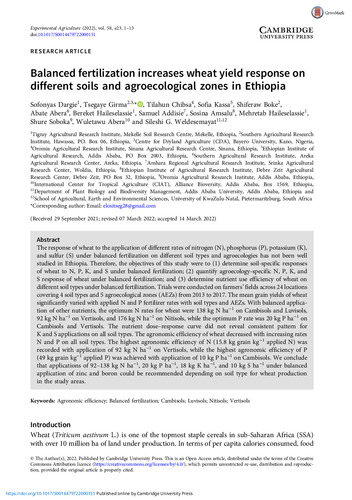Balanced fertilization increases wheat yield response on different soils and agroecological zones in Ethiopia
The response of wheat to the application of different rates of nitrogen (N), phosphorus (P), potassium (K), and sulfur (S) under balanced fertilization on different soil types and agroecologies has not been well studied in Ethiopia. Therefore, the objectives of this study were to (1) determine soil-specific responses of wheat to N, P, K, and S under balanced fertilization; (2) quantify agroecology-specific N, P, K, and S response of wheat under balanced fertilization; and (3) determine nutrient use efficiency of wheat on different soil types under balanced fertilization. Trials were conducted on farmers’ fields across 24 locations covering 4 soil types and 5 agroecological zones (AEZs) from 2013 to 2017. The mean grain yields of wheat significantly varied with applied N and P fertilizer rates with soil types and AEZs. With balanced application of other nutrients, the optimum N rates for wheat were 138 kg N ha−1 on Cambisols and Luvisols, 92 kg N ha−1 on Vertisols, and 176 kg N ha−1 on Nitisols, while the optimum P rate was 20 kg P ha−1 on Cambisols and Vertisols. The nutrient dose–response curve did not reveal consistent pattern for K and S applications on all soil types. The agronomic efficiency of wheat decreased with increasing rates N and P on all soil types. The highest agronomic efficiency of N (15.8 kg grain kg−1 applied N) was recorded with application of 92 kg N ha−1 on Vertisols, while the highest agronomic efficiency of P (49 kg grain kg−1 applied P) was achieved with application of 10 kg P ha−1 on Cambisols. We conclude that applications of 92–138 kg N ha−1, 20 kg P ha−1, 18 kg K ha−1, and 10 kg S ha−1 under balanced application of zinc and boron could be recommended depending on soil type for wheat production in the study areas.

